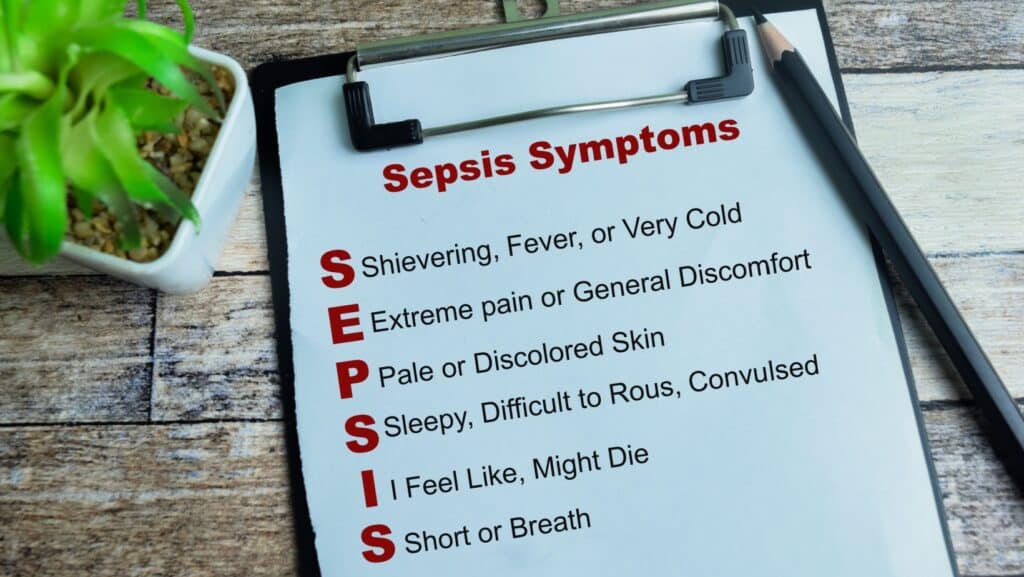10 Early Signs Of Sepsis Americans Often Miss Until It’s Too Late
Sepsis, a life-threatening reaction to infection, often goes unnoticed until it’s too late. The Centers for Disease Control and Prevention (CDC) estimates that sepsis affects over 1.7 million Americans each year and contributes to more than 250,000 deaths annually. Despite its severity, many people mistake sepsis symptoms for less serious ailments, delaying crucial medical intervention. Knowing how to recognize the signs early can make a critical difference. Here are 10 reasons why sepsis signs are missed and how early detection could save limbs, life, and more.
1. Confusing Sepsis Symptoms with the Flu or a Cold

Sepsis often starts with symptoms that mimic common illnesses like the flu, including fever, chills, and fatigue. According to the Mayo Clinic, this similarity can lead many people to believe they’re simply battling a seasonal bug, causing them to delay seeking medical attention. However, when these flu-like symptoms are accompanied by a rapid heart rate or quickened breathing, sepsis could be the underlying issue. Recognizing these warning signs is critical, as early intervention is key to preventing sepsis from progressing into a life-threatening condition.
2. Misinterpreting Mental Confusion as Stress or Fatigue

A sudden change in mental clarity, such as confusion or difficulty concentrating, is often attributed to stress or fatigue, especially in busy adults or seniors. The National Institutes of Health (NIH) explains that sepsis can cause a sudden drop in blood pressure and inadequate oxygen delivery to the brain, resulting in these cognitive symptoms. This is particularly concerning for older adults who may already experience mild cognitive impairment, making it harder to distinguish. Recognizing mental confusion in the context of an infection could be an early indicator of sepsis.
3. Attributing Rapid Heart Rate and Breathing to Anxiety

When people experience a rapid heartbeat or fast breathing, they often assume anxiety or panic is to blame. However, the American Association of Critical-Care Nurses (AACN) warns that these are also hallmark signs of sepsis, indicating that the body is struggling to deliver enough oxygen to tissues. When these symptoms occur alongside fever or an infection, it’s crucial not to dismiss them as mere anxiety. Addressing these signs early can prevent the condition from escalating.
4. Assuming Low Blood Pressure Is Due to Dehydration

Many people mistake low blood pressure for dehydration, especially after exercise or in hot weather. However, the Cleveland Clinic explains that when sepsis begins to impact blood flow, it can lead to dangerously low blood pressure, which compromises blood supply to vital organs. This can cause organ failure if not treated immediately. Recognizing low blood pressure as a potential symptom of sepsis—rather than merely dehydration—can save lives.
5. Ignoring Decreased Urination or Changes in Skin Color

Symptoms such as decreased urination and changes in skin color (e.g., pale or bluish skin) often go unnoticed because they develop gradually. The Sepsis Alliance highlights that these signs indicate that sepsis is reducing blood flow to the kidneys and skin, leading to organ dysfunction. Decreased urination and unusual skin coloration in someone with a known infection should be seen as serious red flags requiring immediate medical attention.
6. Overlooking Severe Pain as a Symptom of Sepsis

People often associate severe pain with a specific injury or chronic condition. The CDC cautions that pain, particularly when it’s severe or described as the “worst ever,” could indicate that sepsis is affecting internal organs or tissues. Ignoring pain in the context of infection is dangerous, as it can signal the spread of bacteria or the body’s inflammatory response worsening, both of which can lead to life-threatening consequences.
7. Misjudging Extreme Fatigue as General Weakness

Extreme fatigue, often dismissed as a result of overexertion or lack of sleep, is another subtle sign of sepsis. Johns Hopkins Medicine explains that sepsis-induced fatigue results from the body’s overwhelming response to infection, which diverts energy from normal functions to fight the invading pathogen. If someone becomes abnormally weak or lethargic and has a concurrent infection, it’s essential to consider sepsis as a potential cause.
8. Ignoring Shivering or Muscle Pain as Minor Issues

Shivering and muscle pain are commonly dismissed as minor inconveniences, especially when attributed to benign conditions like a mild viral infection. The World Health Organization (WHO) emphasizes that uncontrolled shivering can indicate that the body is struggling to regulate its temperature due to sepsis. Muscle pain can also signify that the infection is spreading, leading to inflammation and damage to muscle tissues.
9. Not Connecting Gastrointestinal Symptoms to Sepsis

Nausea, vomiting, diarrhea, and abdominal pain are often mistaken for food poisoning or a stomach virus. However, the UK Sepsis Trust advises that gastrointestinal symptoms, when they appear alongside signs of infection, should raise concern for sepsis. Ignoring these signs can delay diagnosis and treatment, increasing the risk of severe complications, including multi-organ failure.
10. Failing to Recognize the Risk of Losing Limbs and Life

The most devastating consequence of missed sepsis is death or the loss of limbs due to septic shock. Survivor Corps reports that up to 20% of severe sepsis survivors may experience amputations because the condition can cause tissue death and gangrene. This occurs when decreased blood flow and clotting result in the need for surgical removal of affected limbs. Recognizing sepsis early can prevent such tragic outcomes.
Conclusion: Knowing the Signs Can Save Lives

Sepsis is a medical emergency that requires immediate attention, yet it is frequently missed due to its vague and common symptoms. The CDC emphasizes that sepsis is preventable and treatable if recognized early. Understanding the subtle signs of sepsis—like confusion, severe pain, and low blood pressure—can mean the difference between life and death. By staying vigilant and seeking medical attention promptly when these symptoms appear, individuals can significantly improve their outcomes and reduce the risk of severe complications, such as organ damage or limb loss.
10 Stroke Symptoms Americans Ignore All the Time

Strokes are a leading cause of disability and death in the United States, yet many Americans still overlook critical warning signs. According to the Centers for Disease Control and Prevention (CDC), someone in the U.S. has a stroke every 40 seconds, and it’s estimated that around 800,000 people experience a stroke each year. Early detection and prompt medical treatment are essential, as timely intervention can significantly reduce the risk of severe complications or death. This article highlights 10 often-ignored stroke symptoms and explains why recognizing them is crucial.
READ: 10 Stroke Symptoms Americans Ignore All the Time
10 Early Signs of Dementia That Americans Ignore All the Time

Dementia is a progressive neurological condition that affects millions of Americans, often going unnoticed in its early stages. According to the Centers for Disease Control and Prevention (CDC), dementia is not a single disease but a general term for a decline in cognitive ability severe enough to interfere with daily life. Alzheimer’s disease is the most common cause of dementia, accounting for 60-80% of all cases. Recognizing the warning signs can lead to earlier diagnosis and better outcomes. Here are 10 symptoms that Americans frequently overlook, along with credible sources for further information.
READ: 10 Early Signs of Dementia That Americans Ignore All the Time
Peanut Allergies on the Rise: What Every Parent Needs to Know

Peanut allergies are one of the most common food allergies, especially in children. Approximately 1-2% of the population in Western countries is affected by peanut allergies, with rates appearing to increase over the last few decades. Studies show that in the United States, peanut allergy prevalence among children rose from 0.4% in 1997 to 1.8% in 2010, though the rate of increase may be slowing.
READ: Peanut Allergies on the Rise: What Every Parent Needs to Know
Colorectal Cancer Rising Among Millennials and Gen Z: 5 Essential Ways to Protect Yourself

Colorectal cancer, once considered a disease predominantly affecting older adults, is increasingly being diagnosed in people under 50. This alarming trend has significant implications for Millennials and Gen Z. We explore the factors contributing to this rise and provide five crucial strategies to safeguard your health.
READ: Colorectal Cancer Rising Among Millennials and Gen Z: 5 Essential Ways to Protect Yourself
Why Do Mosquitos Seem To Like Me So Much, and What Can I Do About It?

Have you ever wondered why mosquitoes seem to prefer biting some people over others? Understanding the reasons behind this can help in mitigating their impact. Mosquitoes are attracted to certain individuals due to factors like body odor, carbon dioxide, and body heat. These pests are not just annoying; they can also carry dangerous diseases such as malaria, dengue fever, and Zika virus. In this article, we explore why mosquitoes are drawn to specific people, the health risks they pose, and effective strategies to protect yourself from their bites.
READ: Why Do Mosquitos Seem To Like Me So Much, and What Can I Do About It?
Is There A Link Between Being A ‘Good Girl’ And Autoimmune Disease In Women?

Women Rising®, an 11x award-winning women’s empowerment and media company founded by autoimmune-diagnosed, 15x award-winning documentary filmmaker, Sara Hirsh Bordo, recently released findings from Autoimmunity and the “Good Girls” ™ the first-ever sociological survey exploring the intersection between empowerment and autoimmunity in American women. READ: Is There A Link Between Being A ‘Good Girl’ And Autoimmune Disease In Women?
Join Us

Join us on this empowering journey as we explore, celebrate, and elevate “her story.” The Queen Zone is not just a platform; it’s a community where women from all walks of life can come together, share their experiences, and inspire one another. Welcome to a space where the female experience takes center stage. Sign up for our newsletter so you don’t miss a thing, Queen!







